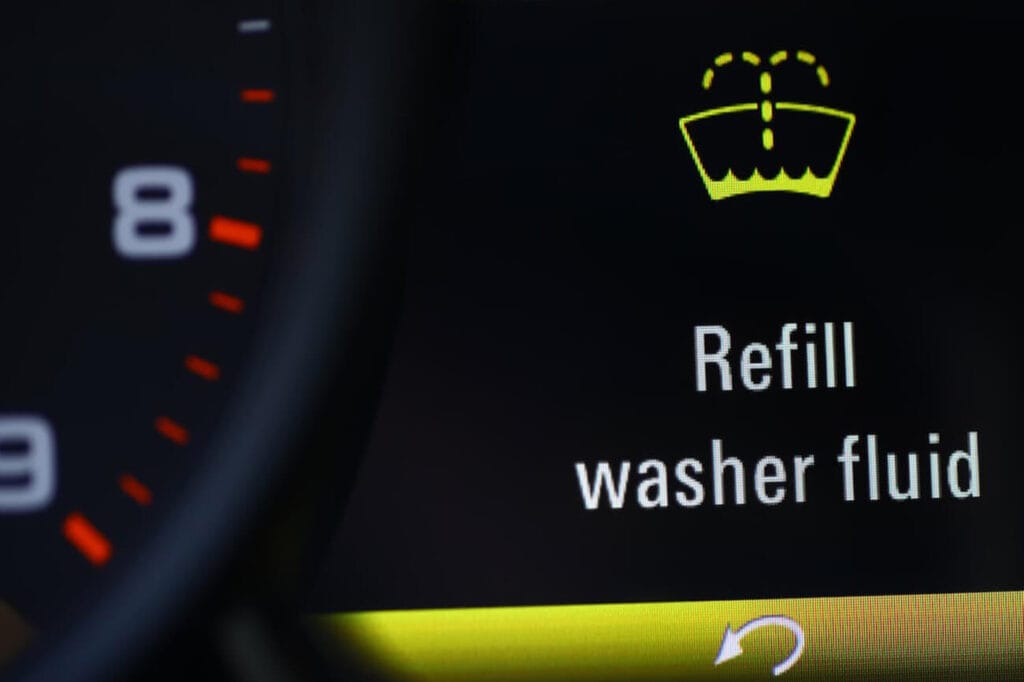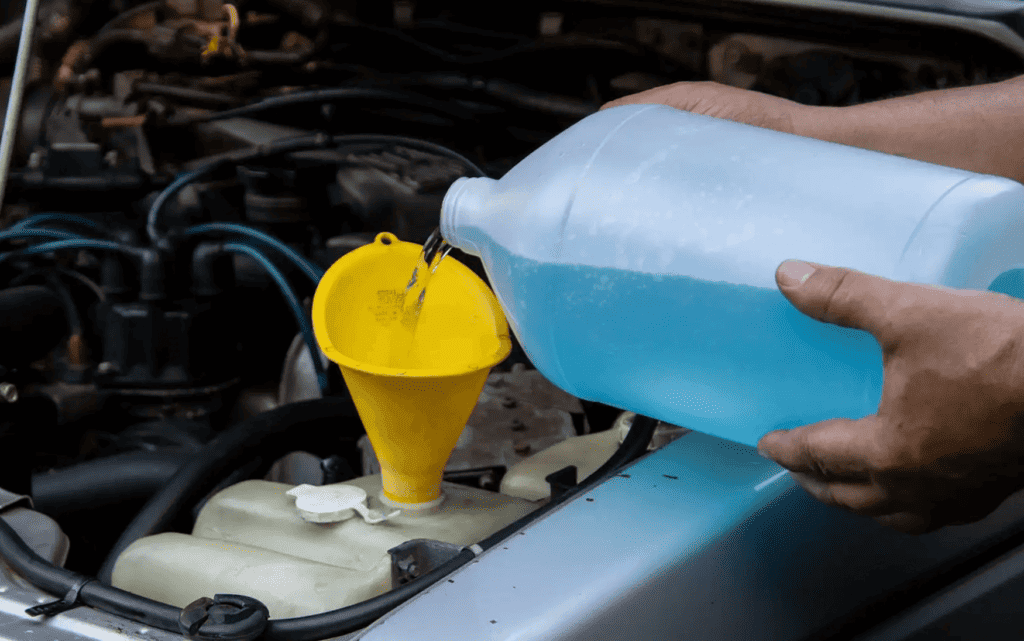The Often-Overlooked Importance of Windshield Washer Fluid Systems
You’d be surprised to learn that windshield washer fluid systems are the unsung heroes of road safety. Far too often, we forget about these little systems, nestled away in our vehicles, until we find ourselves squinting through a dirty windshield on a sunny day. Indeed, an adequately functioning windshield washer fluid system is essential for both vehicle safety and convenience.
Decoding the Dashboard: What the Washer Fluid Warning Light Tells You
• Dashboard 101: The washer fluid warning light is like your car’s way of tapping you on the shoulder. You’ll usually see an icon resembling a windshield or a water droplet. If you’re a newcomer to the intricate world of dashboard lights, this particular one is your vehicle signaling that your washer fluid level is dangerously low. Don’t ignore it; your car is essentially communicating its needs to you.
• More Than Just a Light: Think of this warning light as an unsung hero rather than a nagging indicator. While it’s easy to dismiss it as trivial, it’s as crucial to road safety as a seatbelt or a brake light. This little light serves as a timely reminder that the ability to clear your windshield effectively is part and parcel of a safe driving experience.
• Clear the Way: Imagine driving through a blizzard or a torrential downpour with a muddy windshield. Unthinkable, right? Washer fluid serves as your first line of defense against the elements, clearing away not just snow or rain, but also other types of debris and grime that can adhere to your windshield. So when the light comes on, it’s telling you that your visibility insurance is running low.

• A Lesson in Visibility: It’s a fact that a dirty or grimy windshield can obscure your vision, but let’s quantify this a bit. Reduced visibility can double the likelihood of an accident, especially in high-traffic areas or at speeds exceeding 60 km/h. Your windshield is essentially your window to the world when driving; don’t let it become a blurry mess.
• Don’t Wait, Act: Procrastination might be fine for some things, but not here. When you see that light go on, make it a point to refill your windshield washer fluid at the first available opportunity. Failing to act can compromise not only your safety but also that of others on the road. Most gas stations offer washer fluid, and the refill process is so straightforward that it barely takes a few minutes.
False Alarms and Phantom Warnings: When the Light Says ‘Low’ But You’re Full
• The Puzzle of the Persistent Light: Even after refilling the fluid, sometimes the warning light continues to stay on. This is usually due to a sensor malfunction.
• Sensor Glitches: The sensors that measure washer fluid can fail or get obstructed, causing inaccurate readings.
• Check for Obstructions: Dirt, grime, or debris can sometimes clog the sensor, causing it to misread the fluid levels.
• System Interconnectedness: Faulty sensors aren’t just an isolated problem; they can sometimes affect other warning systems in your car.
• Time for a Check-up: Persistent false alarms are a sign that you need to get the sensor checked, possibly replaced.
A Closer Look at Sensors: How They Work and Where They Hide
Hidden from plain sight but integral to your vehicle’s functionality is the washer fluid level sensor. Typically located at the bottom of your washer fluid reservoir, these humble sensors perform a function akin to that of a sentinel. They work on a principle of electrical resistance. When your fluid level is adequate, the electrical current flows smoothly. But as the fluid level drops, the electrical resistance changes, and this fluctuation is detected by your car’s computer.
If this shift reaches a certain threshold, the sensor triggers your dashboard warning light. It’s an unobtrusive way your car communicates with you about the need to replenish your washer fluid. So the next time that washer fluid warning light flickers on, take a moment to appreciate the little sensor nestled at the bottom of your washer fluid reservoir. It might be out of sight, but it’s hard at work ensuring you don’t compromise your driving safety.
Is It Safe? Driving with a Low Washer Fluid Warning Light On
We get it—the temptation to press on even when that pesky washer fluid light comes on is all too real. But hold your horses. While you might think you’re in the clear on a sunny day, taking this light for granted is a gamble, especially if you find yourself on muddy lanes or snowy paths later on. In less-than-ideal driving conditions, the absence of washer fluid could substantially compromise your visibility, creating a veritable safety hazard.
Imagine driving through a snowstorm; every time a vehicle passes you, a cloud of slush splatters onto your windshield. Without washer fluid to clear the mess, your visibility goes from bad to worse in seconds. Even if you’ve gotten away with it in the past, remember that compromised visibility is one of the leading causes of accidents.
Repair and Maintenance: Sensor Fixes and Washer Fluid Pump Testing
• Sensor Replacement: If the sensor is faulty, it usually needs to be replaced. These replacements typically cost between $20-$50.
• Sound the Alarm: You can test the washer fluid pump by activating the fluid switch. If you hear a sound but no fluid is ejected, your pump might be the issue.
• Pump Costs: A washer fluid pump replacement will generally set you back between $100-$200, depending on your vehicle’s make and model.
• Do It Yourself: Some minor issues, like a clogged sensor, can often be fixed at home. A simple cleaning can sometimes solve the problem.
• Professional Help: For more complicated issues, it’s advisable to consult with professionals. Some repairs may require specialized tools and expertise.

Filling It Up: How Much Is Too Much?
Refilling your washer fluid reservoir is a breeze, but a lack of caution could set you back. It’s not just about pouring until you can pour no more. Overfilling your reservoir can lead to unintended consequences, like leaks that could cause slippery pedals or impair the sensor’s functionality.
Most washer fluid reservoirs are designed to hold a specific volume of liquid, generally between 3.5 to 4 liters. To avoid overdoing it, aim to leave a bit of room—at least an inch—from the top of the reservoir. This small precaution can prevent complications like leaks or sensor malfunctions. Trust us, the last thing you want is to create a new problem while trying to solve another.
Wash Away Your Worries, but Keep an Eye on That Light
In summary, your windshield washer fluid system is more than a luxury—it’s a safety feature that deserves your attention. Warning lights, including the washer fluid light, are your car’s way of communicating vital information. They shouldn’t be ignored. If you ever find yourself puzzled by any warning light, consider a professional check-up. And if you’re in Canada, Uchanics offers mobile mechanic services that can address these issues right at your doorstep. Because, after all, why worry when you can wash those troubles away?
By paying attention to these warning lights and maintaining your vehicle’s various systems, you’re not just ensuring your own safety, but you’re also contributing to safer roads for everyone.
